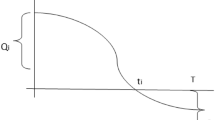Abstract
In this present study we have considered a deterministic inventory model in which we have taken deterioration as a function of time and demand function is considered initially linear for some time and next exponential. In the presence of uncertainty all the cost parameters are taken as generalized triangular fuzzy number. The proposed inventory model has been solved by fuzzy nonlinear programming approach and Pythagorean fuzzy goal programming approach. Finally we have taken numerical examples and sensitivity analysis for some cost parameters.






Similar content being viewed by others
Data availability
Not applicable.
References
Harris, F.W.: Economic order quantity model. Inst. Oper. Res. Manag. Sci. 38(6), 937–946 (1915)
Aggarwal, S.P., Jaggi, C.K.: Ordering policies of deteriorating items under permissible delay in payment. J. Oper. Res. Soc. 46, 658–662 (1995)
Gupta, R., Vrat, P.: Inventory model for stock-dependent consumption rate. Opsearch 23, 19–24 (1986)
Ghare, P.M., Schradar, G.P.: A model for an exponentially decaying inventory. J. Ind. Eng. 14, 238–243 (1963)
Giri, B.C., Goswami, S., Chaudhuri, K.S.: An EOQ model for deteriorating items with time varying demand and costs. J. Oper. Res. Soc. 47(11), 1398–1405 (1996)
Giri, B.C., Chakrabarty, T., Chaudhuri, K.S.: An EOQ model for items with weibull distribution deterioration, shortages and trended demand. J. Oper. Res. Soc. 25, 649–657 (1998)
Wee, H.M., Law, S.H.: Economic production lot size for deteriorating items taking account of the time-value of money. Comput. Oper. Res. 26, 545–558 (1999)
Sachan, R.S.: Inventory policy model for deteriorating items with time proportional demand. J. Oper. Res. Soc. 35, 1013–1019 (1984)
Wu, J.W., Lin, C., Tan, B., Lee, W.C.: An EOQ inventory model with time-varying demand and Weibull deterioration with shortages. Int. J. Syst. Sci. 31, 677–683 (2000)
Dye, C.Y., Chang, H.J., Teng, J.T.: A deteriorating inventory model with time-varying demand and shortage-dependent partial backlogging. Eur. J. Oper. Res. 172, 417–429 (2006)
Mishra, V.K., Singh, L.S., Kumar, R.: An inventory model for deteriorating items with time-dependent demand and time-varying holding cost under partial backlogging. J. Ind. Eng. Int. 9, 4 (2013)
Omar, B.M., Amos, A., Olalekan, D.: An inventory model for linearly time-dependent deteriorating rate and time-varying demand with shortages partially backlogged. J. Intell. Fuzzy Syst. 38(4), 4545–4557 (2020)
Zadeh, L.A.: Fuzzy sets. Inf. Control. 8, 338–353 (1965)
Roig, G., Ghoshray, S., Yen, K.K.: A linear regression model using triangular fuzzy number coefficients. Fuzzy Sets Syst. 106, 167–177 (1999)
Angelov, P.P.: Optimization in an intuitinistic fuzzy enviornment. Fuzzy Sets Syst. 86, 299–306 (1997)
Das, S.K., Islam, S.: Fuzzy multi Item inventory model with deterioration and demand dependent production cost under space constraint using neutrosophic hesitant fuzzy programming approach. Infin. Study 28, 281–294 (2019)
Yager, R.R.: Pythagorean fuzzy subsets. In: Proceedings of the joint IFSA world congress NAFIPS annual meeting, pp 57–61 (2013)
Islam, S., Das, K.: Multi-objective inventory model with deterioration under space constraint: neutrosophic hesitant fuzzy programming approach. Neutrosophic Sets Syst. 47, 124–146 (2021)
Garg, H.: A linear programming method based on an improved score function for interval-valued pythagorean fuzzy numbers and its application to decision-making. Internat. J. Uncertain. Fuzziness Knowl. Based Syst. 26(01), 67–80 (2018)
Ejegwa, P.A.: Pythagorean fuzzy set and its application in career placements based on academic performance using max–min–max composition. Complex & Intelligent Systems 5, 165–175 (2019)
Acknowledgements
Let us convey our humble gratitude to the department of mathematics, University of Kalyani for their cordial and helpful cooperation by providing us with financial support through DSE-PURSE (Phase-II).
Funding
No funding to be reported.
Author information
Authors and Affiliations
Contributions
Both of the authors equally contributed equally to the above work. Both of them read and approved the final version of the manuscript.
Corresponding author
Ethics declarations
Conflict of interest
Both of the authors declare that they don’t have any competing interests.
Ethics approval and consent to participate
Not applicable.
Consent for publication
Not applicable.
Additional information
Publisher's Note
Springer Nature remains neutral with regard to jurisdictional claims in published maps and institutional affiliations.
Appendix
Appendix
The governing differential equations are given bellow.
We have the boundary condition \(Q_{2i} \left( {t_{2i} } \right) = 0, Q_{1i} \left( 0 \right) = Q_{max}\) and a condition where \(Q_{1i} \left( {t_{1i} } \right) = Q_{2i} \left( {t_{1i} } \right)\).
From (23)
Integrating both sides of (4) we get
Using the condition \(Q_{1i} \left( 0 \right) = Q_{max}\) we get from (27)
Now from (24) we have
This is a linear equation with integrating factor (I.F)\(= e^{{\smallint \alpha_{i} .t.dt}} = e^{{\frac{{a_{i} t^{2} }}{2}}}\).
Therefore,
Now using the condition \(Q_{2i} \left( {t_{2i} } \right) = 0 in \left( {7^{\prime}} \right)and finding the value of C_{2}\) we get,
From the Eq. (25) we have
Integrating (31) we get,
Using the condition \(Q_{3i} \left( {t_{2i} } \right) = 0\) we get from (31)
Equation (28) represents the inventory during the time interval \(0 \le t \le t_{1i} .\)
Equation (30) represents the inventory during the time interval \(t_{1i} \le t \le t_{2i}\).
Equation (33) represents the negative inventory during the time interval \(t_{2i} \le t \le t_{3i}\).
Rights and permissions
Springer Nature or its licensor (e.g. a society or other partner) holds exclusive rights to this article under a publishing agreement with the author(s) or other rightsholder(s); author self-archiving of the accepted manuscript version of this article is solely governed by the terms of such publishing agreement and applicable law.
About this article
Cite this article
Das, K., Islam, S. Fuzzy multi-objective deterministic inventory model with time dependent demand and holding cost under Pythagorean fuzzy goal programming approach. OPSEARCH (2024). https://doi.org/10.1007/s12597-023-00727-z
Accepted:
Published:
DOI: https://doi.org/10.1007/s12597-023-00727-z




